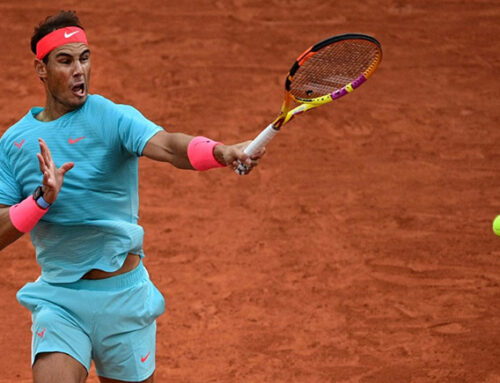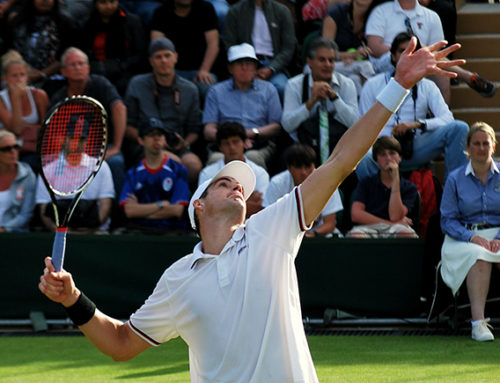Those readers who read Parts 1, 2 and 3 of this series now have a good understanding of why they should play most shots cross-court, and to make offensive and defensive decisions based off their court positioning. In a world where everyone’s strokes were the same, and everyone was of equal height, strength and fitness this would be all you needed to know to win almost all of your tennis matches! Thankfully the tennis world is a place full of variety and differences, and we must add another layer of complexity on top of what we’ve already learned. We’ve long been captivated by rivalries, particularly those that offer a contrast in style: Federer-Nadal, Agassi-Sampras, Borg-McEnroe. This is in part because tennis is a game of matchups. As we become more and more advanced, it is critical that we take into account not only our own strengths and weaknesses, but also those of our opponent. And so today we will add one of the final pieces of your tennis puzzle: finding the winning matchup.
Knowing Your Strengths and Weaknesses
In order to be able to find a winning matchup, you must know your own strengths and weaknesses. Sometimes it can be difficult separating the shot that we like to hit from the one that is actually stronger. We all love success, and it is the nature of our minds that we can easily forget the 10 missed down-the-line forehands because of the 2 beautiful winners we hit with the same shot. We must be able to look at things objectively, and in a fairly subtle way. It isn’t just enough to say “I have a good forehand.” The better you understand the complexities of your stroke the better. How’s your cross-court forehand, vs your inside-out forehand vs your down the line forehand? How’s your forehand on high balls vs low balls? The better you can grasp your strengths on each particular shot in a variety of circumstances the more nuanced your ability to apply these strategies will be. So it begins by paying attention when you play. Get a friend out on the court to feed you a bunch of balls in different scenarios and figure out what you do well and what you do poorly.
Knowing Your Opponent’s Strengths and Weaknesses
This is the harder part. It’s one thing to be playing your friend for your weekly Wednesday morning game – in all likelihood you know their game quite well. But say you’re playing a flex league and it’s your first time playing your opponent? Gaining an understanding of their game in your 5-10 minute warmup can be challenging unless you have a very complex understanding of stroke mechanics. Even then you have to account for someone’s ability to compensate for technical problems in their game with footwork or sheer effort. But we don’t need a perfect understanding of their game, we just need enough of one to start. And that is very easily done in a few easy steps:
1) Pay Attention. Watch what your opponent misses a lot during warmup. Do they miss long or into the net? Do they struggle to hit backhands cross-court? Look for small details and large trends both!
2) Mix it up. Hit them some high balls, some low balls, move them a little side to side (nothing obnoxious, mind you). Make them hit a variety of shots and see what happens! Sometimes a player can handle a low backhand beautifully but can’t make a high one to save their life!
3) Watch them move. Are they fast? Slow? Do they move up and back well vs side to side?
From these three things you can get at least a starting point for your match. And that’s enough because as the match progresses you’ll get more and more information that will help you refine your game plan as you go!
Start With One Key Matchup
This is where you begin: identify one key matchup with which to begin your match. We start with a very simple matchup: is there a cross-court stroke that I hit better than my opponent? For example, is my forehand stronger than their forehand? Is my backhand stronger than their backhand? If the answer to either of these questions is yes (and note we’re assuming that you both play with the same hand for now), then voila – you’ve found your initial key matchup! It really is that simple. Now that we’ve found our key matchup, our goal is to recreate that matchup during points at every reasonable opportunity because if we’ve identified our relative strengths and weaknesses properly, we will win comfortably more than half the points that are played out using this matchup.
Creating Patterns of Play
At lower levels, we can hope and expect that the simple act of playing out our key matchup will be enough to win points in and of itself. For example if I identify the cross-court backhand rally to be my key matchup, then on most points if I simply manage to hit enough cross-court backhands I will eventually either draw an error or hit a winner without needing to do anything else. As players become more advanced, this will only happen sometimes, and instead we are looking to use this matchup as a part of a more complete pattern. In simple terms, I might simply hit that cross-court backhand until I earn a short put-away ball which I then hit for a winner. If my opponent is a better defender then my short putaway might turn into an approach shot. Or if they are Novak Djokovic it might be that I’ve earned a slightly shorter ball, that I then run around and hit an inside-in forehand, earning a slightly shorter cross-court forehand which I take down the line as an approach shot, then finish the point with a volley or overhead. The key thing is trying to find something that is relatively repeatable and predictable that doesn’t rely on ‘shotmaking’ but instead on things that you can consistently do. Our goal after all is to find a “winning matchup”, and we cannot win attempting to hit shots that we cannot make with consistency.
What If There’s No Key Matchup?
But what happens if my forehand isn’t better than his forehand? Or my backhand isn’t better than her backhand? Now there’s no simple matchup that lets me easily follow the cross-court ball and play low risk tennis! Let’s start with the assumption that there is still a matchup, and we’ll run with the classic one – that your forehand is better than their backhand. Our goal, then, is to create a forehand-to-backhand exchange within the rally. This is how we will either draw the error, or earn the shorter ball that we can truly attack. In keeping with our cross-court theme from earlier articles, we want to create a situation which we can hit inside-out forehands into our opponent’s backhand. “Well that’s all well and good, Tactical Tennis, but how do I do that?” We use patterns, of course!
Creating The Inside Out Forehand Opportunity
Obviously most players aren’t fast enough to simply run around their backhand and hit a forehand in the course of normal play. At the lower levels when the ball is generally traveling at lower speeds this might be possible, but as speed of shot increases we must work to create these opportunities for ourselves. Here we will talk specifically about several different ways in which we can create an opportunity for an inside-out forehand. You must use creative thinking to put together similar sequences for yourself in order to create other matchups as appropriate. So let’s look at the steps we need:
1) Create The Time – A key element in getting to hit an inside out forehand is having enough time to run around the ball. The two simplest ways to do this are to hit a higher, more looping shot into their backhand corner and then cheat a little to your own backhand side. The return shot is likely to be higher and looping too, which gives you the time to get all the way around the ball and hit the inside out forehand. A second option is to use the slice, especially if you are capable of floating the slice deep into the backhand corner. Again, cheat to your left (or right if you are left-handed playing another lefty) and move to create your inside out forehand for yourself.
2) Reduce Angles – Another way to do this is to control the angles your opponent has to work with. The wider a ball is, the more angle the person hitting it has to work with. If I want to create an inside out forehand, the closer to the center of the court I can get my opponent to hit the ball the less distance I have to travel to run around my backhand. So, when I get in my cross-court backhand rally, I want to play the ball closer to center than normal, and thus reduce the angles of the shot they can hit back. Beware them hitting a slightly inside-out backhand down the line if you cheat over too far, but this way you should get a ball you can run around in time in order to hit your forehand.
Finding Unusual Matchups
There are examples in the professional game of players whose strengths didn’t fall into these fairly simple categories. Pat Rafter would be one example. Pat’s strengths (volleys and athleticism) were so specialized that he was generally forced to align them against opponent’s strengths and weaknesses in order to give himself the best chance of victory. Sometimes you might play someone who you match up against poorly, and you might be forced to rely on ‘strengths’ you didn’t know you had. Or rather, due to the nature of the matchup, something that isn’t normally a strength is (simply be virtue of your ability to do it better than your opponent). This might result in you attacking the net far more than usual, or hitting a very specific type of shot to expose a very specific weakness of your opponent (a high backhand, or a low forehand for example).
Protecting Your Weakness
Last but certainly not least, how do we protect ourselves from our opponent’s best matchup? Say my opponent has a stronger backhand than I do, how do I avoid losing the match on cross-court backhand exchanges without being forced to hit a ton of backhands down the line (a necessarily high risk shot)? The answer typically lies in height and depth. If you can force your opponent to hit from the red zone (looking back at Part 3 of this series) then their ability to capitalize on the matchup will be blunted (not necessarily eliminated however!). Slow, high play is easier to change direction on at a lower risk than low, fast play. Forcing them back and getting the ball up higher and slower can allow us then to hit a safer down the line backhand and likely get the forehand we want instead.
Conclusion
Most players fall into the trap of either making tennis matches overly complex by needlessly elaborate game plans, or too simple by virtue of no meaningful game plan at all. It’s important when we compete to distill the match down to its essence: find one thing we do better than our opponent and then make the match about doing that one thing. Keeping such a simple and yet effective goal can give players a sense of direction that is critical. Remember: we don’t need to win every point – studies have shown that winning a mere 55% of the points in a match is a 99% chance of victory. Find your key matchup, create it at every reasonable opportunity and see your results improve!


